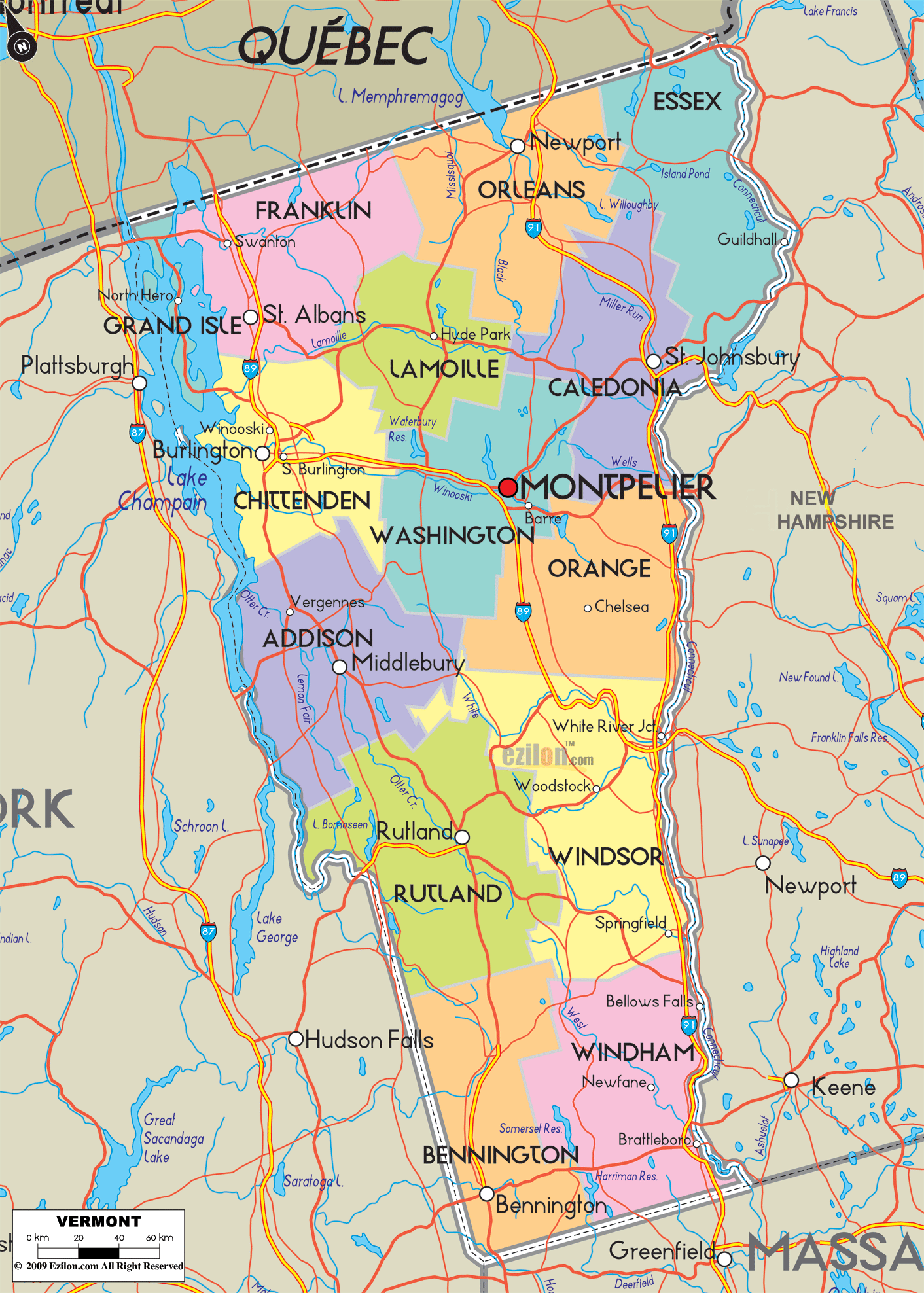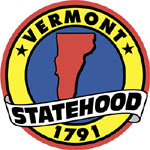

Description: Detailed large map of Vermont State, USA showing cities, towns, county formations, roads highway, US highways and State routes.
 Map of Vermont, featuring cities, counties, and a detailed road network. This detailed map is designed for clarity: every county is color-shaded, each county seat (shire town) is easy to spot, neighboring states and Québec are labeled, and only a small set of clean highway cues are shown for orientation. Lake Champlain and the Green Mountains anchor your view, while the Connecticut River draws the entire eastern boundary with New Hampshire. To the west, you meet New York across Lake Champlain, to the south, Massachusetts, and to the north, Québec.
Map of Vermont, featuring cities, counties, and a detailed road network. This detailed map is designed for clarity: every county is color-shaded, each county seat (shire town) is easy to spot, neighboring states and Québec are labeled, and only a small set of clean highway cues are shown for orientation. Lake Champlain and the Green Mountains anchor your view, while the Connecticut River draws the entire eastern boundary with New Hampshire. To the west, you meet New York across Lake Champlain, to the south, Massachusetts, and to the north, Québec.
Read the county grid first; county names are uppercase and shaded distinctly.
Find the county seat inside each block (e.g., Burlington for Chittenden, Montpelier for Washington, Rutland for Rutland).
Use just a few road-light cues to orient: I-89 (White River Junction-Montpelier-Burlington), I-91 (along the Connecticut River), I-93 (terminates near St. Johnsbury), US-7 (western north–south), US-2 (island causeway and Montpelier-NH link), US-4 (Rutland–Quechee).
The island chain in Lake Champlain forms tiny Grand Isle County, a string of townships between Plattsburgh and Burlington. County seat: North Hero. You can literally trace US-2 stepping from island to island. This is the cleanest way to visualize the islands’ relationship to the Vermont mainland and to New York across the water.
North of Burlington’s latitude and hard on the Québec line, Franklin County shows St. Albans as the county seat. Swanton and Enosburg Falls appear on the map, with dairy valleys rolling north to the border. Missisquoi Bay indents the county’s northwest edge.
Vermont’s population hub, Chittenden County, wraps the Burlington metro on Lake Champlain, with the county seat: Burlington (the state’s largest city). South Burlington and Winooski are clearly marked, as are Essex and the airport corridor. The lake to the west and the Winooski River running east–west make this block instantly recognizable.
The block south of Chittenden is Addison County, anchored by Middlebury (county seat) on Otter Creek. Vergennes (on Otter Creek’s lower falls) is labeled near the lake. The Champlain Valley floor is obvious, bordered by the first ramparts of the Green Mountains.
Compact and central-north, Lamoille County shows Hyde Park as the county seat, Morrisville nearby, and Stowe under Mount Mansfield’s shadow. The county tile nestles between Franklin, Chittenden, Washington, and Caledonia.
Home to the state capital, Montpelier, Washington County also co-hosts county services in Barre (co-shire). The map places Waterbury along I-89 and Northfield to the south, making the valley structure easy to follow.
At the western edge of the Northeast Kingdom, Caledonia has St. Johnsbury as its county seat, a junction where I-91 meets I-93. Lyndonville appears north of it. The Miller Run and Passumpsic River traces help you picture the terrain flow into the Connecticut River.
Orleans reaches the Québec line with Newport on Lake Memphremagog. Willoughby Lake’s glacial cleft is visible east of Brownington. The county’s top edge is the international boundary; the map makes that relationship obvious.
Vermont’s most sparsely populated county, Essex, stretches from the Connecticut River north toward the international line. Guildhall is the county seat; Island Pond (Brighton) is a key inland village. The map shows how the Connecticut River shapes the county’s east.
Between Washington and Windsor sits Orange County, with Chelsea as the county seat. Bradford anchors the lower east side on the river, and you can see how US-302 and VT-110 link the interior to the Connecticut corridor.
Large and diverse, Windsor shows Woodstock as the county seat and a significant marker at White River Junction (interchange town of Hartford) on I-89/I-91. Springfield is labeled in the southeast—the White and Black rivers thread across the block toward the Connecticut.
The Champlain Valley turns mountainous again in Rutland County. County seat: Rutland. You can see Fair Haven by the New York line, Brandon on US-7, and Killington represented by the high spine east of town.
Vermont’s southwest corner is Bennington County with two shire towns: Bennington and Manchester. The color block shows the county touching both New York and Massachusetts; US-7 is the quiet north–south cue.
The southeast corner is Windham County, seat Newfane, with Brattleboro on the Connecticut River and Bellows Falls upstream. The long river boundary with New Hampshire is easy to trace; the map shows how towns hug the water.
County-first design: all 14 counties are shaded distinctly, with their seats labeled and easy to scan.
City clarity: Burlington, Montpelier, Rutland, St. Albans, Newport, Brattleboro, Bennington, and more are placed in natural valleys or along Lake Champlain/Connecticut River.
Road-light: only essential corridors appear (I-89, I-91, I-93, US-7, US-2, US-4) to support orientation without stealing attention from the counties.
Border awareness: Québec, New York, New Hampshire, and Massachusetts are consistently labeled so you can read cross-border context in seconds.
Water + landforms: Lake Champlain, Memphremagog, Willoughby, the Connecticut River, and the Green Mountains are present as subtle, reliable anchors.
Franklin: Find St. Albans a few miles south of the border; Swanton sits near Missisquoi Bay. The block shows dairy flats grading into the first hills toward Lamoille and Chittenden.
Orleans: Newport is on Lake Memphremagog; Derby and Barton sit along north-flowing waters that exit into Québec. Willoughby Lake is a landmark to the south.
Essex: The top right corner, seat of Guildhall, aligns with the upper Connecticut River gorge. The layout makes it obvious how remote and forested this county is compared to the rest of Vermont.
Grand Isle: US-2 stitches South Hero, Grand Isle, and North Hero; the block’s shapes mirror the islands themselves.
Chittenden: Burlington on the lakeshore, South Burlington and Winooski inland, then Essex and Williston toward the hills.
Addison: Middlebury and Vergennes are tied by Otter Creek. The county touches the lake and the mountain foot, matching the classic Champlain Valley profile.
Rutland: The county seat, Rutland, lies beneath the Green Mountain crest; Fair Haven touches New York, while Brandon points north toward Addison.
Lamoille: Hyde Park as seat, Morrisville beside it, Stowe to the south. The county forms a hinge between Champlain towns and the central spine.
Washington: Montpelier (state capital) aligns with the Winooski River, while Barre sits just to the south. Waterbury marks the I-89 corridor into the mountains.
Orange: Chelsea in the interior; Bradford and Newbury along the Connecticut. The map shows small, accurate stream lines radiating from the uplands to the river.
Caledonia: St. Johnsbury is the organizing node, with Lyndonville located north along a valley. The I-91/I-93 meeting is visible but subtle, maintaining the county-first tone.
Orleans and Essex: Together they represent the Kingdom’s variety of glacial lakes, timber uplands, and long east-west rides over divides.
Windsor: Woodstock as county seat, White River Junction at the I-89/I-91 confluence, Springfield further south. The White and Black rivers guide you through the interior towns.
Windham: Brattleboro and Bellows Falls show classic mill-town placement right on the river. Newfane is inland but central; the county’s long eastern edge follows the water to Massachusetts.
Bennington: Bennington and Manchester share shire duties. The county’s triangular stance between Massachusetts and New York is unmistakable. The Taconic foothills and Green Mountain spine bookend the valley.
I-89: From White River Junction (Windsor County) through Montpelier (Washington) up to Burlington (Chittenden).
I-91: Parallel to the Connecticut River from Brattleboro to the Québec line, passing St. Johnsbury, Newport, and numerous river towns.
I-93: Short Vermont segment finishing at St. Johnsbury.
US-7: Western north–south through Bennington, Rutland, Middlebury, Burlington, then north to the border.
US-2: From Grand Isle’s islands through Burlington–Montpelier to New Hampshire.
US-4: Cross-state from Rutland toward Quechee and the river valley.
Residents: verify school-supervisory regions or service zones by county seat and nearby towns; visualize cross-county commutes.
Travelers: match park gateways (e.g., Stowe in Lamoille; Killington in Rutland; Quechee and Woodstock in Windsor; Island Pond in Essex; Lake Willoughby in Orleans).
Students: trace how rivers and mountains shaped settlement-Burlington on the lake, capital at Montpelier in a central valley, St. Johnsbury at a transportation fork.

Physical Map of Vermont
Physical map and map image of Vermont.

Regional Directory of Canada
Information and guide about Canada and website listing.

Regional Directory of United States of America
Information and guide about United States of America and websites with American topics.

Regional Directory of Europe
Information and guide about Europe and websites with European topics.

Regional Directory of Australia
Information and guide about Australia and websites with Australian topics.